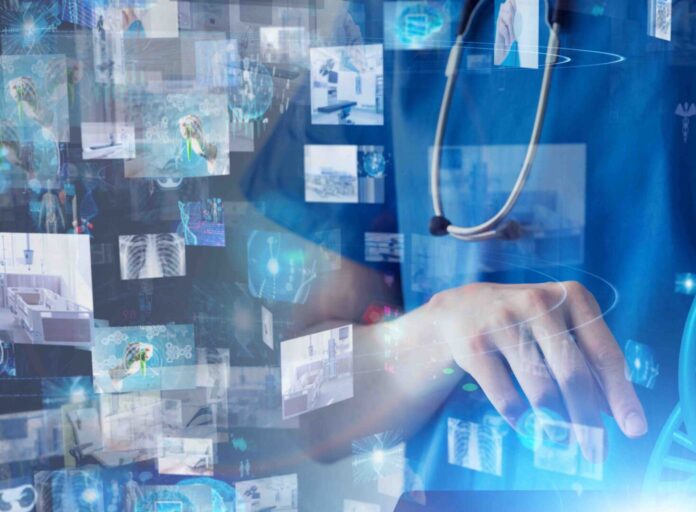It doesn’t seem to matter these days where you live when it comes to seeking the help of your local family physician. Getting an appointment is an ordeal. A May 2023 article in the medical publication STAT, reports Americans wait on average 26 days to get an appointment with their general practitioners. Specialists are a whole other matter. Median wait times average between 18 and 25 weeks for Canadians who are referred by their general practitioner to a specialist for a consultation.
Peter Diamandis has his take on how AI will positively disrupt medical practice. Peter is both a medical doctor and an engineer. He is convinced that AI is the answer to much of what is currently wrong in the state of medicine.
He writes that doctors today are overworked and drowning in data. He quotes data from a 2017 report that stated 30% of physicians spent between 17 and 24 minutes with a patient, and that 29% spent less time, between 13 and 16 minutes per patient. So the majority of patients who wait an average of 26 days to see their family doctor, end up with a face-to-face visit between 13 and 24 minutes.
Why? One of the reasons is the fallout from COVID-19 which has witnessed since 2020 a large number of doctors, particularly general practitioners, retiring. In 2021, 20% of healthcare workers resigned with 117,000 physicians in the United States leaving. That same year only 40,000 got their medical license.
Another reason for physicians drowning in data is the sheer volume of medical information being published today. It is a wonder that doctors can keep up with the 28,000 peer-reviewed medical journals that publish more than 1.8 million articles per year, or roughly 5,000 new papers every day.
Then there is the paperwork and patient record keeping. Patient diagnostic testing results, consult reports, patient visit notes, prescriptions, phone calls to referring specialists, and more fill a doctor’s daily workload. The billing and other administrative tasks of a medical practice add even more to this.
As a patient, you have to ask, can my family physician keep up-to-date in the face of this incoming and outgoing information overload?
Medical AI: a Co-Pilot or a Threat
Should doctors feel threatened by the arrival of AI in their profession? Some may feel that their expertise is not to be trifled with. AI algorithms, some believe, are committing systematic theft on a mass scale using physicians’ online records in the large datasets that AIs use for training.
Others, however, welcome AI for its enhanced capability, speed, consistency, and accuracy in diagnoses. AI algorithms can consume images, test results, case notes and more and do it with blinding speed. An AI can train on hundreds of thousands if not millions of cases. A physician, even a specialist, will only have knowledge and exposure to a fraction of that number.
AIs see subtle patterns that humans miss. AIs can think outside the box and make associated links among data that indicate a disease may be starting. A physician may never see the links at all.
Some physicians fear that dependence on medical AIs will decrease the knowledge possessed by doctors and other health professionals and that the AI black box will take over. A Viewpoint article on the JAMA Network last month entitled “AI’s Threat to the Medical Profession,” notes that fear:
“Most of today’s knowledge on disease mechanisms will be forgotten and we will be ruled by systems that only focus on intervention strategies that will provide the best possible outcome. This era will show a decrease in intellectual debates among colleagues.”
Medical AI Empowers Physicians and Patients
Peter Diamandis argues that knowledge, nor methodologies, will not be forgotten when a medical AI starts working with a general practitioner or specialist. He states the transformation to a partnership between physician and AI co-pilot is to be celebrated and not feared.
Along with the arrival of the Internet-of-Things (IoT) and the proliferation of smart connected sensors and medical devices, medicine is entering a transformative moment with the patient being a partner in achieving healthy outcomes.
I’ll give you an example. When COVID-19 infected my heart I developed arrhythmias (rhythm disturbances) that in my case were considered life-threatening. I bought a Kardiamobile, a device that I could use at home to test my heart. Whether I felt a change or not, the use of this device once a day gave me a 30-second electrocardiogram that I could share with my doctor. I didn’t need an appointment or a lab requisition for me to know my heart’s status, and for my doctor to be kept informed.
The arrival of medical AI and this sensory revolution of medical devices means that wait time issues will no longer be all that relevant. Instead, medical AIs will continually monitor the sensors a patient has on hand and the data produced to assist a doctor without being intrusive.
Peter writes:
“Rather than waiting a month to book your annual medical checkup, sensors on your body, in your body, and your environment (bedroom, bathroom, office, and car) will be constantly monitoring your physiology and uploading data to your medical AI.”
Continuous monitoring will catch diseases at their earliest stages, allow for rapid intervention, and forego medical appointments, hospital visits, or prolonged hospital stays.
Medical AIs will fill the gap created by retired and missing healthcare workers. It will give physicians the means to provide continuous healthcare without being overwhelmed.
















